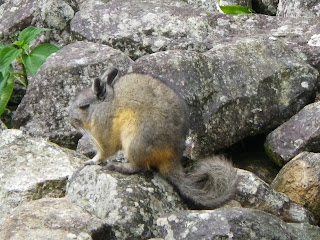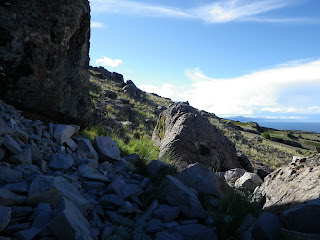At the bus terminal in La Paz, now...we´re going to be in the area until late afternoon, as the bus drivers that drive between here and Oruro are presently on strike...apparently not an uncommon thing to have happen. It´s nice to not be on a bus after about 20 hours of being on one--we came from the swampy-hot lowland jungle all the way to La Paz on the Altiplano, where we drove the last hour or so through snowy mountain rises.
Back to about a month ago, some pictures to fill in the gaps--with its arid southern coastal desert, it was somewhat surprising to encounter such an abundance of life which the ocean brings--here are a few pictures for illustration...
 |
| Peruvian boobies nest in dried-guano bowl-shaped nests high up on coastal bluffs |
 |
| Said bluffs...here we also saw Humboldt penguins, Inca terns, red-legged cormorants, Peruvian pelicans, a sea otter, and sea lions--a sharp contrast with the inland landscape, which was covered by a surface crust of crystallized salt and sand (you could tap on the surface and hear its hollow resonance, cavernous as the salt crystal formations were) |
 |
| One of at least three lizard species we found near the cliff´s edge; aside from some lichens, there were no forms of photosynthesizing life for miles. |
 |
| I´m convinced these are human artifacts, not certain from when (Jen found them semi-buried in a rock pile). The notch in the darker stone made for a comfortable spot to rest one´s thumb, while the lighter rock appeared to have been repeatedly struck by other rocks (difficult to see in this picture). A means for cracking open crabs? |
|





















































